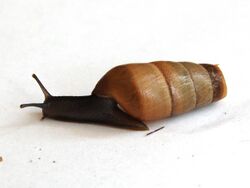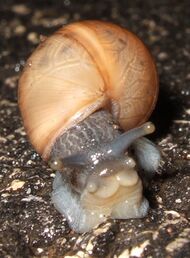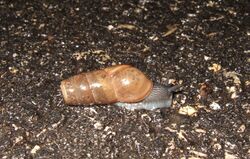Biology:Decollate snail
| Rumina decollata | |
|---|---|

| |
| A live individual of the decollate snail | |
| Scientific classification | |
| Domain: | Eukaryota |
| Kingdom: | Animalia |
| Phylum: | Mollusca |
| Class: | Gastropoda |
| Subclass: | Heterobranchia |
| Order: | Stylommatophora |
| Suborder: | Achatinina |
| Superfamily: | Achatinoidea |
| Family: | Achatinidae |
| Subfamily: | Rumininae |
| Genus: | Rumina |
| Species: | R. decollata
|
| Binomial name | |
| Rumina decollata | |
| Synonyms | |
| |
The decollate snail, scientific name Rumina decollata, is a medium-sized predatory land snail, a species of terrestrial pulmonate gastropod mollusk in the family Achatinidae.[4] It is a European species that has been introduced in a number of areas worldwide.
Varieties
- Rumina decollata var. cruda Monterosato, 1892
- Rumina decollata var. cylindrica Monterosato, 1892
- Rumina decollata var. dentata Pallary, 1922
- Rumina decollata var. fusca Pallary, 1899
- Rumina decollata var. maura Crosse, 1873
- Rumina decollata var. pellucida Monterosato, 1892
- Rumina decollata var. solida Monterosato, 1892
- Rumina decollata var. striatula Pallary, 1920
Distribution
This species is native to the Mediterranean excluding south-east Mediterranean.[5]
It is introduced in Israel and in Egypt[6] since Roman times. It has been introduced into North America, including Phoenix and Glendale, Arizona, and other areas Fresno, California[7][2] as a biological control agent, in hopes of controlling populations of the brown garden snail.[8]
Also found in southern Brazil , and in Great Britain, as a "hothouse alien".
Shell description
The shell of the decollate snail is long and roughly cone-shaped. It grows to approximately 40–45 mm (1.6–1.8 in) in length and a width of 14 mm (0.55 in),[9] and upon reaching mature size, grinds or chips off the end of its own shell by moving its body roughly against hard surfaces, so that the shell takes on a decollate shape, tapering to a blunt end.
Life habits


Sexual maturity occurs at approximately 10 months. An adult is capable of laying 500 eggs in its lifetime. The eggs are deposited singly in the soil and hatch within 10–45 days.[9]
Rumina decollata is a voracious predator, and will readily feed upon common garden snails and slugs and their eggs. The snail eats plant matter as well, but this generalist predator is indiscriminate in its feeding and has been implicated in the decimation of native gastropods (including non-pest species) and beneficial annelids.[9]
Decollate snails are tolerant of dry and cold conditions, during which they burrow deep into the soil. They are most active during the night and during rainfall.
References
- ↑ 1.0 1.1 Gómez Moliner, B.J. (2017). "Rumina decollata (Europe assessment)". IUCN Red List of Threatened Species 2017: e.T171533A105796803. https://www.iucnredlist.org/species/171533/105796803. Retrieved 16 June 2023.
- ↑ 2.0 2.1 "Rumina decollata". NatureServe. https://explorer.natureserve.org/Taxon/ELEMENT_GLOBAL.2.106780/Rumina_decollata.
- ↑ Linnaeus C. 1758. Systema naturae per regna tria naturæ, secundum classes, ordines, genera, species, cum characteribus, differentiis, synonymis, locis. Tomus I. Editio decima, reformata. pp. [1-4], 1-824. Holmiae. (Salvius).
- ↑ Bank, R. (2017). Classification of the Recent terrestrial Gastropoda of the World. Last update: July 16, 2017.. World Register of Marine Species, Retrieved 10 January 2019.
- ↑ "Rumina decollata". https://snailsuk.weebly.com/rumina-decollata.html.
- ↑ Commonwealth of Australia. 2002 (April) Citrus Imports from the Arab Republic of Egypt. A Review Under Existing Import Conditions for Citrus from Israel . Agriculture, Fisheries and Forestry, Australia. Caption: Gastropods, page 12 and Appendix 2.
- ↑ "Rumina decollata". Species. GBIF. http://www.gbif.org/species/2294129.
- ↑ Wilen, Cheryl A.; Flint, Mary Louise. "Pests in Gardens and Landscapes: Snails and Slugs". University of California Dep. Agriculture and Natural Resources. http://ipm.ucanr.edu/PMG/PESTNOTES/pn7427.html.
- ↑ 9.0 9.1 9.2 "Fact Sheet: Rumina decollata". Center for Plant Health Science and Technology (CPHST). https://idtools.org/id/mollusc/factsheet.php?name=Rumina%20decollata.
- Herbert, D.G. (2010). The introduced terrestrial Mollusca of South Africa. SANBI Biodiversity Series, 15: vi + 108 pp. Pretoria.
Further reading
- Mienis H. K. (2002). "Rumina paivae: the giant decollated snail from North Africa". Triton 5: 33–34.
External links
- Rumina decollata on the UF / IFAS — Featured Creatures website.
- A photo of decollates feeding on Helix (ivy)
- Crosse H. (1873). Diagnoses molluscorum novorum. Journal de Conchyliologie. 21(2): 136-144.
- Coquand H. (1862). Géologie et Paléontologie de la région sud de la Provence de Constantine. Mémoires de la Société d'Emulation de la Provence. 2: 5-342.
- Bieler, R. & Slapcinsky, J. (2000). A case study for the development of an island fauna: Recent terrestrial mollusks of Bermuda. Nemouria. 44: 1-99.
- Sparacio, I., Surdo, S., Viviano, R., Liberto, F. & Reitano, A. (2021). Land molluscs from the Isola delle Femmine Nature Reserve (north-western Sicily, Italy) (Gastropoda Architaenioglossa Pulmonata). Biodiversity Journal. 12 (3): 589–624
- ohnson, C. W. (1900). Some notes on Rumina decollata Linn. The Nautilus. 13(10): 117.
- Smith, H. H. (1912). Rumina decollata in Mobile and New Orleans. The Nautilus. 26(1): 4-6
- Ferriss, J. H. (1914). Rumina decollata in Texas. The Nautilus. 28(1): 11
Wikidata ☰ Q834936 entry
 |



